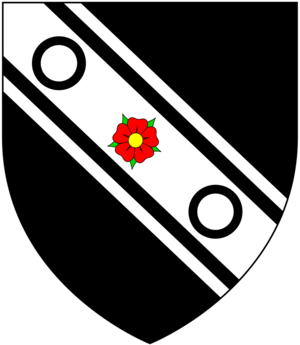Edward Conway, 1st Earl of Conway facts for kids
Quick facts for kids
The Earl of Conway
|
|
|---|---|

Arms of Conway: Sable, on a bend cotised argent a rose gules between two annulets of the first
|
|
| Secretary of State for the Northern Department | |
| In office 2 February 1681 – January 1683 |
|
| Monarch | Charles II |
| Preceded by | Sir Leoline Jenkins |
| Succeeded by | Sidney Godolphin |
| Personal details | |
| Born |
Edward Conway
c. 1623 |
| Died | 11 August 1683 (aged 59) |
| Resting place | Arrow, Warwickshire, England |
| Nationality | English |
| Political party | Tory |
| Spouses |
Elizabeth Booth (d. 1681) Ursula Stawell |
| Occupation | Politician |
Edward Conway, who became the 1st Earl of Conway (born around 1623 – died 11 August 1683), was an important English politician. He lived at Ragley Hall in Warwickshire. From 1681 to 1683, he worked as the Secretary of State for the Northern Department. This was a very important job in the government of King Charles II.
Contents
Who Was Edward Conway?
Edward Conway was born around 1623. His father was Edward Conway, the 2nd Viscount Conway. His mother was Frances Popham. Her father, Sir Francis Popham, was also a Member of Parliament (MP).
Edward Conway's Career
When his father died in 1655, Edward became the 3rd Viscount Conway. This title was part of the English nobility, called the Peerage of England. He also became the 3rd Viscount Killultagh in Ireland.
In 1660, he joined the Privy Council of Ireland. This was a group of advisors to the King in Ireland. He was a close friend of James Butler, the 1st Duke of Ormonde.
Edward Conway was very interested in science. On 2 January 1668, he became a Fellow of the Royal Society. This is a famous group that promotes science. In 1671, he became the governor of Charlemont Fort. From 1679, he was the Master of the Ordnance in Ireland. This job involved managing weapons and military supplies.
On 3 December 1679, King Charles II made him the Earl of Conway. This was an even higher title. Then, on 2 February 1681, he joined the King's main Privy Council. He also became the Secretary of State for the Northern Department. This role meant he handled important government business, especially with countries to the north.
He left this job in January 1683. There were some claims that he had not followed the King's instructions properly. He also served as the Lord Lieutenant of Warwickshire from 1682 to 1683. This role meant he represented the King in the county of Warwickshire.
Edward Conway's Marriages
Edward Conway was married three times. Sadly, none of his children lived past infancy.
- His first marriage was on 11 February 1651. He married Anne Finch, who was a philosopher. They had one son, Heneage, who died very young from smallpox. After Anne passed away in 1679, Edward went to live at his family home, Ragley Hall.
- His second wife was Elizabeth Booth. She passed away in July 1681.
- His third wife was Ursula Stawell. She outlived him and later married John Sheffield, who became the 1st Duke of Buckingham and Normanby.
Death and Burial
Edward Conway died on 11 August 1683. He was buried in Arrow, Warwickshire.
Who Inherited His Estates?
Since Edward Conway had no children who survived, his titles ended when he died. In his will, he left his estates, including Ragley Hall, to his young cousin, Popham Seymour. Popham was only eight years old at the time. Edward asked Popham to use the Conway family name and coat of arms. So, Popham became known as Popham Seymour-Conway.
Later, Popham's nephew, Francis Seymour-Conway, 1st Marquess of Hertford, inherited Ragley Hall. His family still lives there today.

